Mazda Premacy 2002 User Manual

J54L_8R34_EE_02H.BOOK Page 1 Monday, July 15, 2002 9:03 AM
A Word to Mazda Owners
Thank you for choosing a Mazda. We at Mazda design and build vehicles with complete customer satisfaction in mind.
To help ensure enjoyable and trouble-free operation of your Mazda, read this manual carefully and follow its recommendations.
An Authorised Mazda Dealer knows your vehicle best. So when maintenance or service is necessary, that's the place to go.
Our nationwide network of Mazda professionals is dedicated to providing you with the best possible service.
We assure you that all of us at Mazda have an ongoing interest in your motoring pleasure and in your full satisfaction with your Mazda product.
Mazda Motor Corporation
HIROSHIMA, JAPAN
Important Notes About This Manual
Keep this manual in the glove box as a handy reference for the safe and enjoyable use of your Mazda. Should you resell the vehicle, leave this manual with it for the next owner.
All specifications and descriptions are accurate at the time of printing. Because improvement is a constant goal at Mazda, we reserve the right to make changes in specifications at any time without notice and without obligation.
Please be aware that this manual applies to all models, equipment and options. As a result, you may find some explanations for equipment not installed on your vehicle.
©2002 Mazda Motor Corporation Printed in Japan Aug. 2002(Print1)
Form No. 8R34-EE-02H

J54L_8R34_EE_02H.BOOK Page 2 Monday, July 15, 2002 9:03 AM
How to Use This Manual
We want to help you get the most driving pleasure from your vehicle. Your owner's manual, when read from cover to cover, can do that in many ways.
Illustrations complement the words of the manual to best explain how to enjoy your Mazda. By reading your manual, you can find out about the features, important safety information, and driving under various road conditions.
The above symbol in this manual means “Do not do this ” or “Do not let this happen”.
References to left hand and right hand are made as if facing in the same direction the vehicle faces. Although this manual explains a left-hand-drive model, it also applies to right-hand-drive models.
Index: A good place to start is the Index, an alphabetical listing of all information in your manual.
You’ll find several WARNINGs, CAUTIONs, and NOTEs in the manual.
 WARNING
WARNING
A WARNING indicates a situation in which serious injury or death could result if the warning is ignored.
 CAUTION
CAUTION
A CAUTION indicates a situation in which bodily injury or damage to your vehicle, or both, could result if the caution is ignored.
NOTE
A NOTE provides information and sometimes suggests how to make better use of your vehicle.
The above symbol, located on some parts of the vehicle, indicates that this manual contains information related to the part.
Please refer to the manual for a detailed explanation.
Form No. 8R34-EE-02H

J54L_8R34_EE_02H.BOOK Page 3 Monday, July 15, 2002 9:03 AM
Table of Contents
Your Mazda at a Glance |
1 |
Interior, exterior views and part identification of your Mazda.
Essential Safety Equipment |
2 |
Use of safety equipment, including seats, seat belt system, SRS air bags and child-restraint systems.
Knowing Your Mazda |
3 |
Explanation of basic operations and controls; opening/closing and adjustment of various parts.
Before Driving Your Mazda |
4 |
|
|
Important information about driving your Mazda. |
|
|
|
|
|
|
|
|
|
|
|
Driving Your Mazda |
5 |
|
|
Explanation of instruments and controls. |
|
|
|
|
|
|
|
|
|
|
|
Interior Comfort |
6 |
|
|
Use of various features for drive comfort, including air-conditioning and audio |
|
|
|
|
|
|
|
|
|
|
|
system. |
|
|
|
|
|
|
|
In Case of an Emergency |
7 |
|
|
Helpful information on what to do in an emergency. |
|
|
|
|
|
|
|
|
|
|
|
Maintenance and Care |
8 |
|
|
How to keep your Mazda in top condition. |
|
|
|
|
|
|
|
|
|
|
|
Customer Information |
9 |
|
|
Important consumer information including warranties and add-on equipment. |
|
|
|
|
|
|
|
|
|
|
|
Specifications |
10 |
|
|
Technical information about your Mazda. |
|
|
|
|
|
|
|
|
|
|
|
Index |
11 |
|
|
|
|
|
|
Form No. 8R34-EE-02H
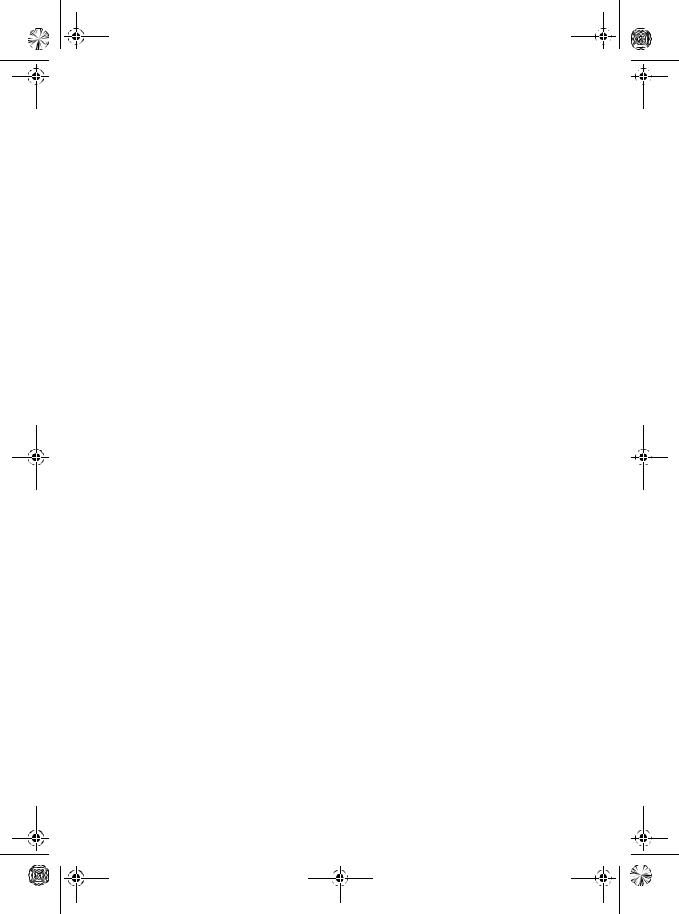
J54L_8R34_EE_02H.BOOK Page 4 Monday, July 15, 2002 9:03 AM
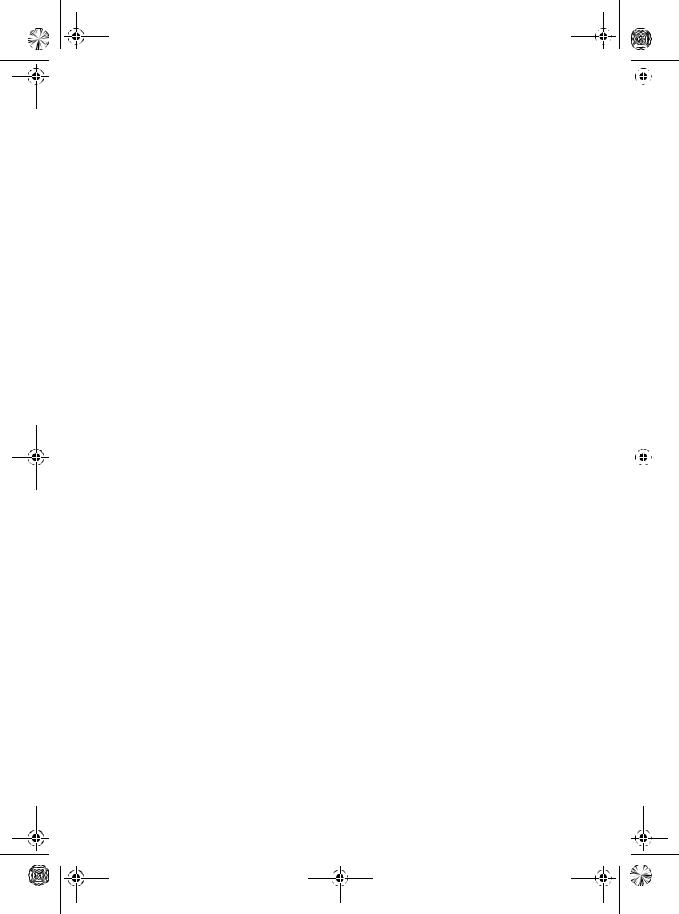
J54L_8R34_EE_02H.BOOK Page 1 Monday, July 15, 2002 9:03 AM
|
|
|
|
|
|
|
|
|
|
|
|
|
|
|
|
|
|
|
1 |
Your Vehicle at a Glance |
|
|
|
|
|
|
|
|
|
|
|
|
|
|
|
|
|
Interior, exterior views and part identification of your Mazda. |
|
|
|
|
|
|
|
|
|
|
|
|
|
|
|
|
|
Instrument Panel Overview ....................................................... |
1- 2 |
|
|
|
|
|
|
|
Interior Overview ........................................................................ |
1- 3 |
|
|
|
|
|
|
|
Exterior Overview ....................................................................... |
1- 4 |
|
|
|
|
|
|
|
|
|
|
|
|
|
|
|
|
|
|
|
|
|
|
|
|
|
|
|
|
|
|
|
|
1-1
Form No. 8R34-EE-02H
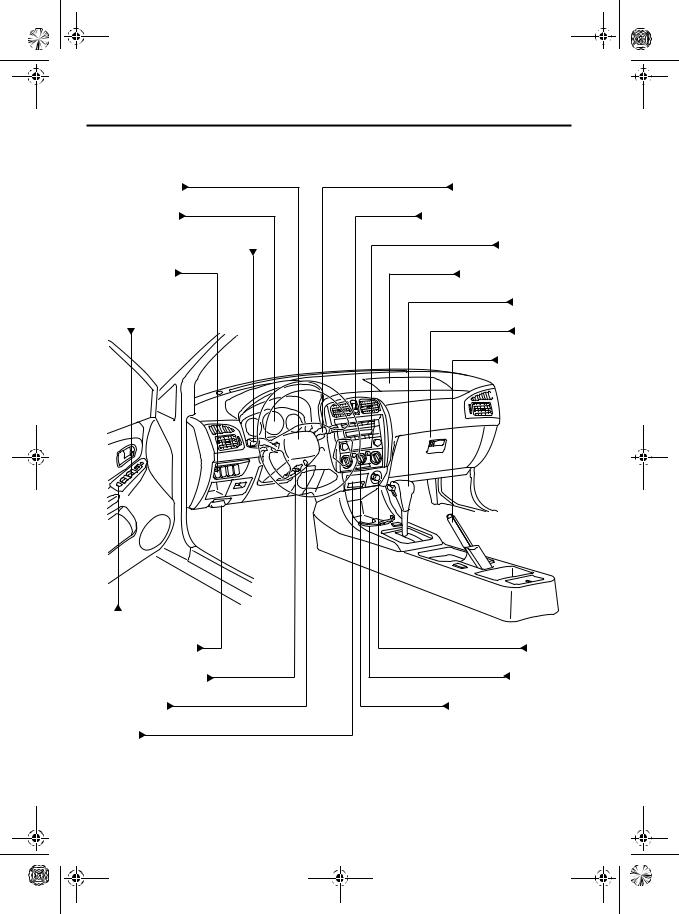
J54L_8R34_EE_02H.BOOK Page 2 Monday, July 15, 2002 9:03 AM
Your Vehicle at a Glance
Instrument Panel Overview
Driver-side air bag |
Wiper and washer lever |
(page 2-66) |
(page 5-41) |
Instrument cluster |
Hazard warning flasher switch |
(page 5-20) |
(page 5-45) |
Lighting control/Direction indicators |
Audio system |
(page 5-38) |
(page 6-16) |
Fog lights switch |
Passenger-side air bag |
(page 5-40) |
(page 2-66) |
Power window switches |
Shift lever |
(page 3-12) |
(page 5-11) |
|
Glove box |
|
(page 6-59) |
|
Parking brake |
|
(page 5-6) |
Power window lock switch |
|
(page 3-15) |
|
Bonnet release handle |
Lighter |
(page 3-16) |
(page 6-55) |
Tilt wheel release lever |
Cup holder |
(page 3-26) |
(page 6-57) |
Ignition switch |
Air-conditioning system |
(page 5-2) |
(page 6-2) |
Ashtray |
|
(page 6-56) |
|
1-2
Form No. 8R34-EE-02H

J54L_8R34_EE_02H.BOOK Page 3 Monday, July 15, 2002 9:03 AM
Your Vehicle at a Glance
Interior Overview
Sunvisors |
(page 6-52) |
Seat belts |
(page 2-36) |
Interior light |
(page 6-52) |
Third-row seat
(page 2-28)
Rear seat/Second-row seat 
(page 2-19)
Map light |
(page 6-53) |
Rearview mirror |
(page 3-29) |
Vanity mirror |
(page 6-52) |
Front seats |
(page 2-2) |
Side air bags |
(page 2-66) |
1-3
Form No. 8R34-EE-02H
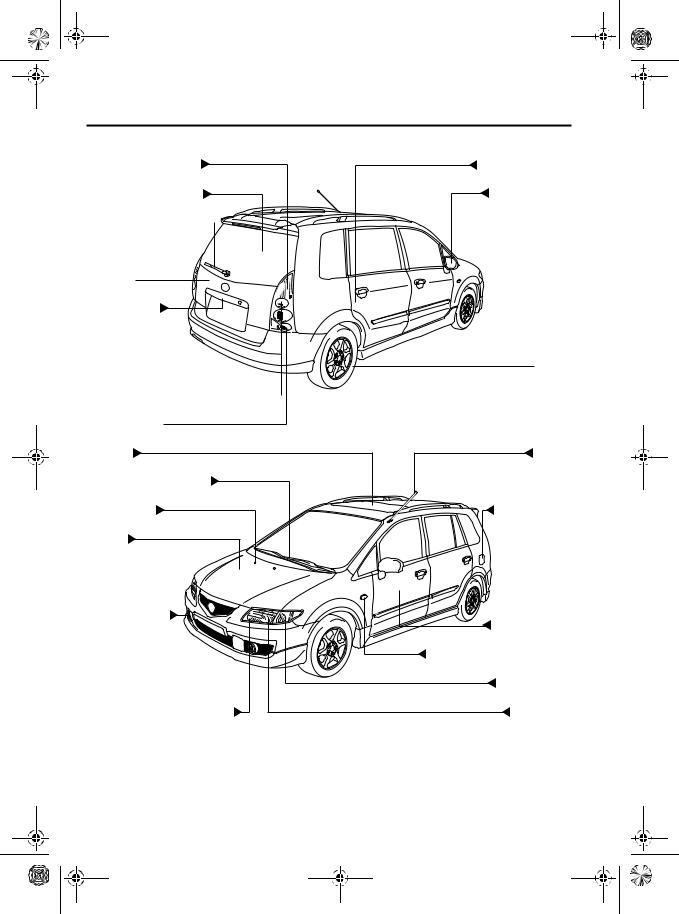
J54L_8R34_EE_02H.BOOK Page 4 Monday, July 15, 2002 9:03 AM
Your Vehicle at a Glance
Exterior Overview
Brake lights/Tail lights |
Child safety locks |
(page 8-41) |
(page 3-9) |
Rear window defroster |
Outside mirrors |
(page 5-43) |
(page 3-26) |
Rear windscreen  wiper blades
wiper blades
(page 8-29)
Liftgate 
(page 3-9)
License plate lights
(page 8-41)
 Tyres
Tyres
(page 8-32)
Rear direction indicator lights 
(page 8-41)
Reverse lights 
(page 8-41)
Sunroof |
Aerial |
(page 3-17) |
(page 6-16) |
Windscreen wiper blades |
|
(page 8-27) |
|
Washer fluid |
Fuel-filler flap |
(page 8-23) |
(page 3-15) |
Bonnet |
|
(page 3-16) |
|
Front fog lights |
Doors and keys |
|
(page 8-39) |
||
(page 3-2) |
||
|
||
|
Side-direction indicator lights |
|
|
(page 8-39) |
|
|
Parking lights |
|
|
(page 8-39) |
|
Front direction indicator lights |
Headlights |
|
(page 8-39) |
(page 8-37) |
1-4
Form No. 8R34-EE-02H
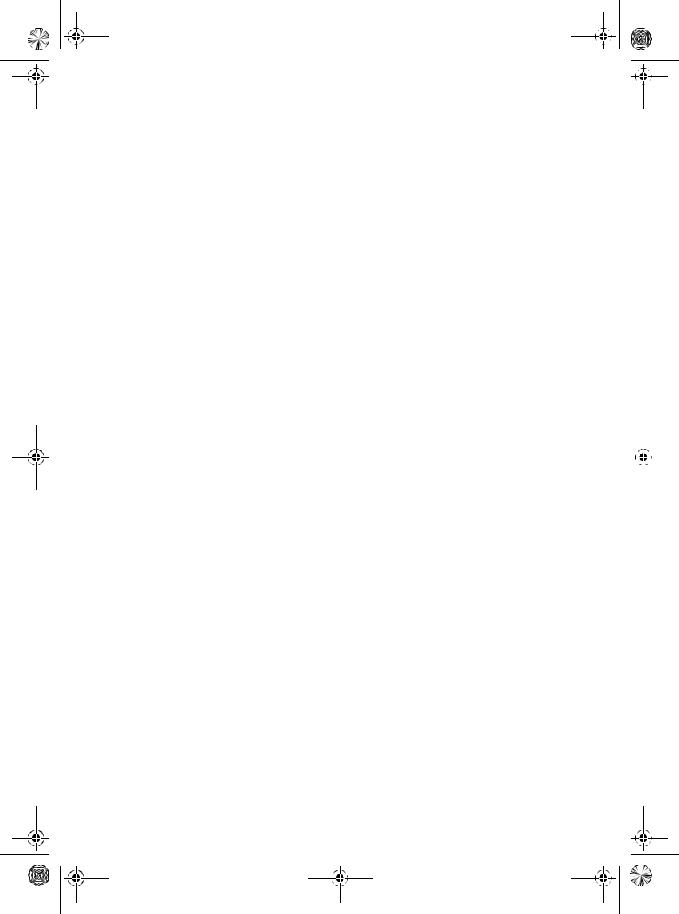
J54L_8R34_EE_02H.BOOK Page 1 Monday, July 15, 2002 9:03 AM
|
2 |
Essential Safety Equipment |
|
|
|
Use of safety equipment, including seats, seat belt system, SRS air bags and child-restraint systems.
..............................................................................................Seats |
2- |
2 |
|
|
|
|
...............................................................................Front Seats |
2- |
2 |
|
|
|
|
Rear Seats (5-Passenger Model) .............................................. |
2- |
9 |
|
|
|
|
Second-Row Seats (7-Passenger Model) ................................. |
2-19 |
|
|
|
|
|
Third-Row Seat (7-Passenger Model) ..................................... |
2-28 |
|
|
|
|
|
Flat Folding (7-Passenger Model) ........................................... |
2-35 |
|
|
|
|
|
Seat Belt Systems ......................................................................... |
2-36 |
|
|
|
|
|
Seat Belt Precautions ............................................................... |
2-36 |
|
|
|
|
|
3-Point Type Seat Belt ............................................................. |
2-40 |
|
|
|
|
|
Front Seat Belt Pretensioner and Load Limiting Systems ...... |
2-42 |
|
|
|
|
|
Rear Centre Position Seat Belt (5-Passenger Model) .............. |
2-44 |
|
|
|
|
|
2-Point Type Seat Belt (7-Passenger Model) |
2-47 |
|
|
|
|
|
|
|
|
|
|||
Seat Belt Warning Light (Except European Model) ................ |
2-48 |
|
|
|
|
|
Child Restraint |
2-49 |
|
|
|
|
|
|
|
|
|
|||
.....................................................Child Restraint Precautions |
2-49 |
|
|
|
|
|
Categories of Child-Restraint Systems (Europe) .................... |
2-52 |
|
|
|
|
|
Child-Restraint System Installation Position (Europe) ........... |
2-53 |
|
|
|
|
|
Child-Restraint System Suitability for Various Seat Positions |
|
|
|
|
|
|
Table (Europe) ......................................................................... |
2-58 |
|
|
|
|
|
Installing Child-Restraint Systems .......................................... |
2-59 |
|
|
|
|
|
Air Bag Cut-Off System .......................................................... |
2-62 |
|
|
|
|
|
ISOFIX Bar-Secured Child-Restraint Systems ....................... |
2-62 |
|
|
|
|
|
SRS Air Bags ............................................................................... |
2-66 |
|
|
|
|
|
Supplementary Restraint Systems (SRS) Precautions ............. |
2-66 |
|
|
|
|
|
Air Bag System Description .................................................... |
2-70 |
|
|
|
|
|
2-1
Form No. 8R34-EE-02H

J54L_8R34_EE_02H.BOOK Page 2 Monday, July 15, 2002 9:03 AM
Essential Safety Equipment
Seats
Front Seats
 WARNING
WARNING
Securing the Seats:
Adjustable seats and seatbacks that are not securely locked are dangerous. In a sudden stop or collision, the seat or seatback could move, causing injury. Make sure the adjustable components of the seat are locked in place by attempting to slide the seat forward and backward and rocking the seatback.
▼Seat Slide
 WARNING
WARNING
Driver’s Seat Adjustment: Adjusting the driver’s seat while the vehicle is moving is dangerous. The
driver could lose control of the vehicle and have an accident. Adjust the driver’s seat only when the vehicle is stopped.
To move a seat forward or backward, raise the lever and slide the seat to the desired position and release the lever.
Lever
Make sure the lever returns to its original position and the seat is locked in place by attempting to push it forward and backward.
2-2
Form No. 8R34-EE-02H
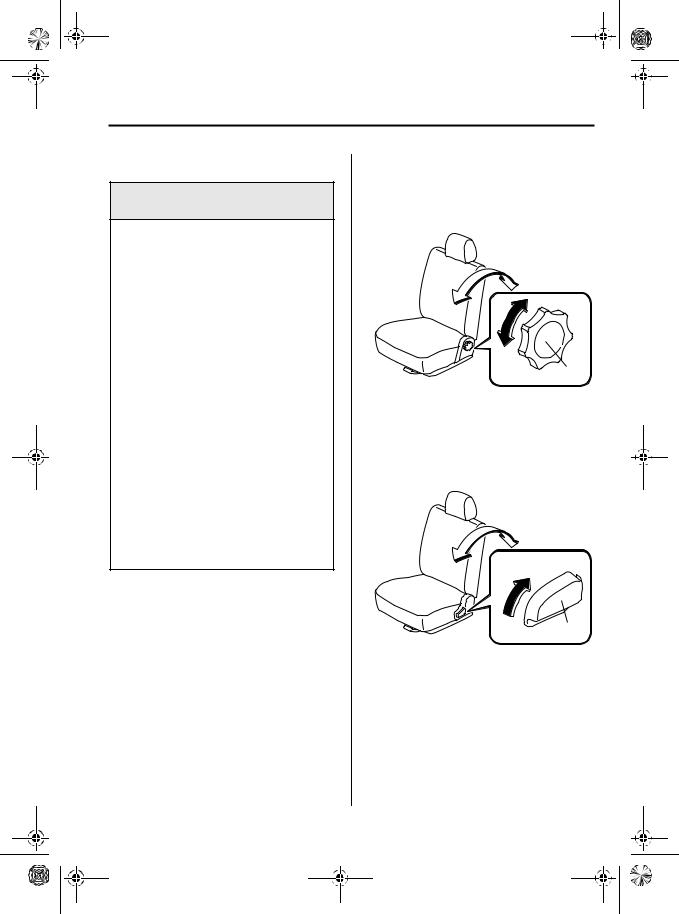
J54L_8R34_EE_02H.BOOK Page 3 Monday, July 15, 2002 9:03 AM
Essential Safety Equipment
Seats
▼Seat Recline
 WARNING
WARNING
Reclining:
Sitting in a reclined position while the vehicle is moving is dangerous because you don’t get the full protection from seat belts. During sudden braking or a collision, you can slide under the lap belt and suffer serious internal injuries. For maximum protection, sit well back and upright.
Unlocked Seatback:
A seatback plays an important role in your protection in a vehicle. Leaving the seatback unlocked is dangerous as it can allow passengers to be ejected or thrown around and baggage to strike occupants in a sudden stop or collision, resulting in severe injury. After adjusting the seatback at any time, even when there are no other passengers, rock the seatback to make sure it is locked in place.
(Type A)
To change the seatback angle, lean forward slightly while rotating the dial. Then lean back to the desired position.
Dial
(Type B)
To change the seatback angle, lean forward slightly while raising the lever. Then lean back to the desired position and release the lever.
Lever
2-3
Form No. 8R34-EE-02H
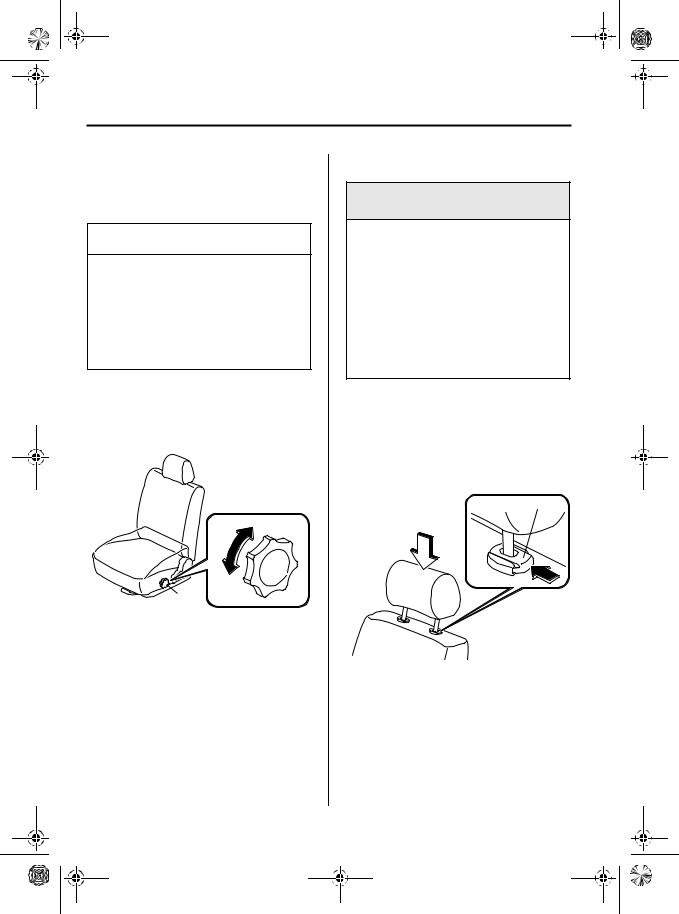
J54L_8R34_EE_02H.BOOK Page 4 Monday, July 15, 2002 9:03 AM
Essential Safety Equipment
Seats
Make sure the lever returns to its original position and the seatback is locked in place by attempting to push it forward and backward.
 CAUTION
CAUTION
When returning a rear-reclined seatback to its upright position, make sure you support the seatback while operating the seatback lever. If the seatback is not supported, it will flip forward suddenly and could cause injury.
▼Seat Tilt (Driver’s Seat)
The seat-bottom angle can be adjusted by rotating the dial.
Up
Down
Dial
▼Head Restraint
 WARNING
WARNING
Head Restraints Adjustment: Driving with the head restraints adjusted too low or removed is dangerous. With no support behind your head, your neck could be seriously injured in a collision. Always drive with the head restraints inserted when seats are being used and make sure they are properly adjusted.
Height adjustment
To raise a head restraint, pull it up to the desired position.
To lower the head restraint, press the stopcatch release, then push the head restraint down.
Stop-catch release
Adjust the head restraint so that the top is parallel with the top of the passenger’s ears, never the passenger’s neck.
2-4
Form No. 8R34-EE-02H
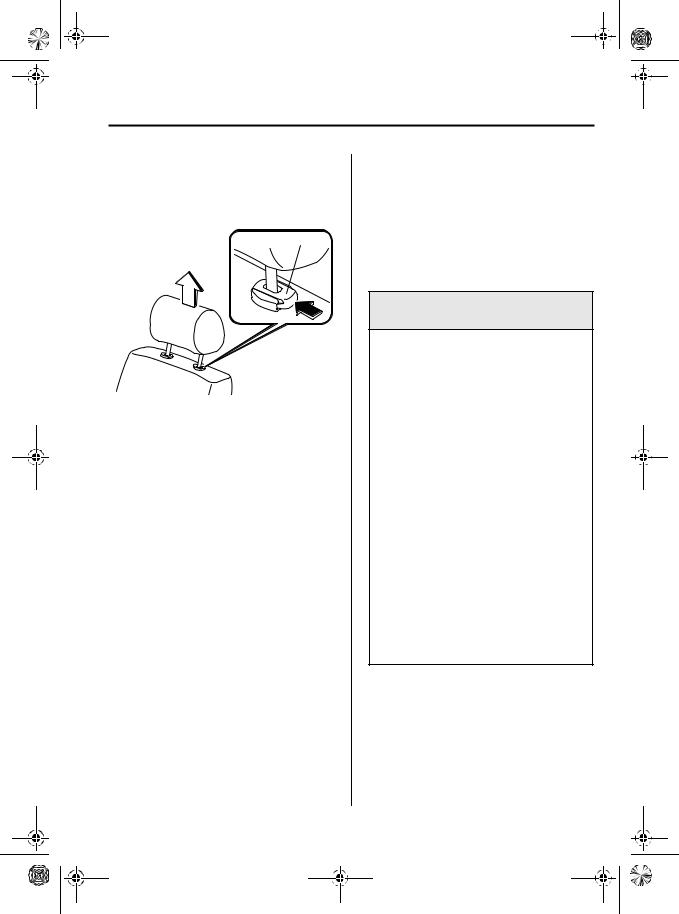
J54L_8R34_EE_02H.BOOK Page 5 Monday, July 15, 2002 9:03 AM
Essential Safety Equipment
Seats
Removal
To remove the head restraint, press the stop-catch release, then pull up on the head restraint.
Stop-catch release
▼Folding the Passenger’s Seat
The passenger’s seatback can be folded down and used as a table while the vehicle is not moving.
The front and rear passenger’s seatbacks can be folded down for placement of long objects. Make sure the object is secure.
 WARNING
WARNING
Using Folded Seatback as a Table While the Vehicle is Moving: Using the folded seatback as a table while driving is dangerous. During
sudden braking or a collision, objects placed on the folded seatback could become projectiles that could hit and injure someone. Never use the folded seat as a table while the vehicle is moving.
Unsecured Objects:
Not securing objects placed on the folded seatback is dangerous. During sudden braking or a collision, the objects could hit passengers and cause serious injuries, or the objects could hit the shift lever, forcing you to lose control of the vehicle. When placing objects on the folded seatback, always make sure they are secure.
2-5
Form No. 8R34-EE-02H

J54L_8R34_EE_02H.BOOK Page 6 Monday, July 15, 2002 9:03 AM
Essential Safety Equipment
Seats
 WARNING
WARNING
Passenger on the Folded Seatback: Driving with a passenger on the folded seatback is dangerous. Allowing a child to sit up on the folded seatback while the vehicle is moving is particularly dangerous. In a sudden stop or even a minor collision, a child not in a proper seat or child-restraint system and seat belt could be thrown forward, back or even out of the car resulting in serious injuries or death. The child or other objects in the baggage area could be thrown into other occupants and cause serious injury. Never allow a passenger to sit or stand on the folded seatback while the vehicle is moving.
To fold the seatback
 CAUTION
CAUTION
Folding the seatback without tucking the seat belt buckle down could damage the seatback.
1.Tuck the seat belt buckle all the way down.
Buckle
2.Raise the reclining lever or pull the lean forward lever. Make sure the seatback is at its maximum forward reclined position.
Lever
Lean forward lever
2-6
Form No. 8R34-EE-02H
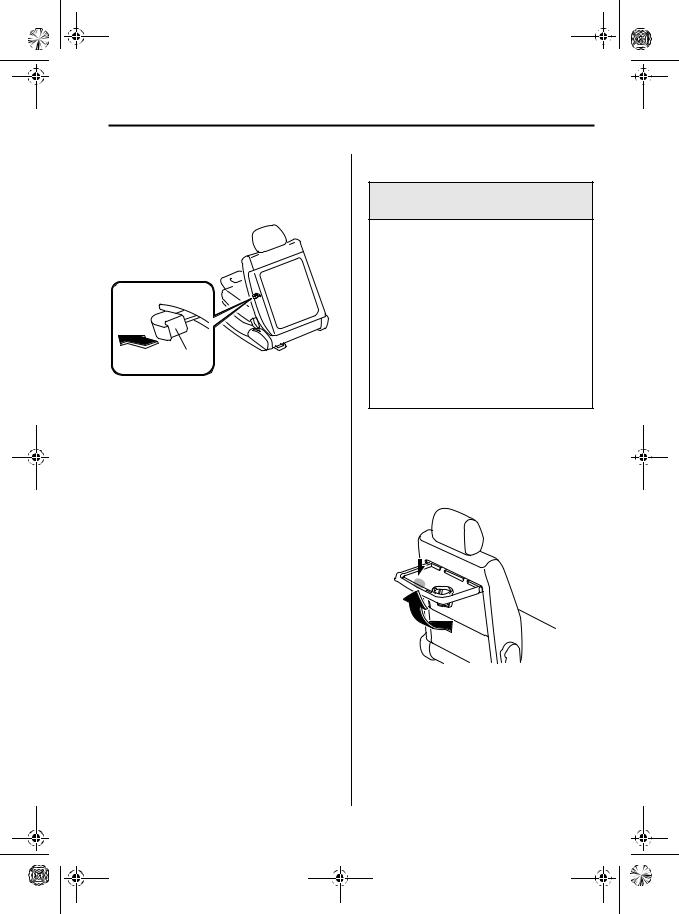
J54L_8R34_EE_02H.BOOK Page 7 Monday, July 15, 2002 9:03 AM
Essential Safety Equipment
Seats
3.Push the fold-down lever forward and push the seatback all the way down. Make sure the seatback is locked.
Fold-down lever
To return the seatback to the upright position
1.Push the fold-down lever down to unlock the seat.
2.Push the seatback to the upright position. Make sure the seatback is locked.
▼Pull-up Seatback Trays
 WARNING
WARNING
Using Seatback Trays While Vehicle is Moving
Using the seatback trays while the vehicle is moving is dangerous. During sudden braking or a collision, rear seat passengers could be thrown forward into a tray causing serious injury. Objects placed on a seatback tray could become projectiles that could hit and injure someone. Always collapse and secure the trays before driving the vehicle.
Pull-up trays are available in the seatbacks of the front seats and can be used when the vehicle is parked.
Grasp the front, central part of the tray when setting up or collapsing it.
2-7
Form No. 8R34-EE-02H

J54L_8R34_EE_02H.BOOK Page 8 Monday, July 15, 2002 9:03 AM
Essential Safety Equipment
Seats
 CAUTION
CAUTION
•Do not place heavy objects on a seatback tray. Heavy objects could cause the tray to collapse and injure someone.
•Do not recline the front seats when the seatback trays are in use. Hot liquids may cause scalding if spilled, or objects could fall causing injury.
▼Armrest
The armrest can be used or placed upright.
 WARNING
WARNING
Positioning the Shoulder Belt Over the Armrest:
Positioning the shoulder portion of a front seat belt over the armrest is dangerous as it cannot provide adequate protection in a collision and could result in serious injuries. Never position the shoulder portion of a front seat belt over the armrest.
2-8
Form No. 8R34-EE-02H
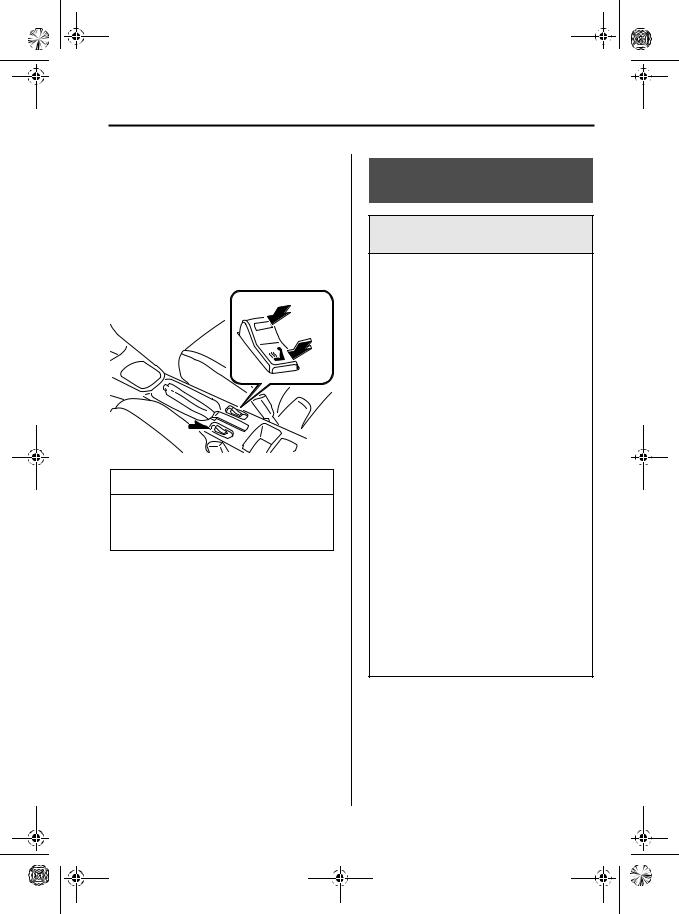
J54L_8R34_EE_02H.BOOK Page 9 Monday, July 15, 2002 9:03 AM
Essential Safety Equipment
Seats
▼Seat Warmer
The front seats are electrically heated. The ignition switch must be in the ON position.
Press the switch to turn the seat warmer on or off. When the switch is in the ON position, the indicator light will come on.
 ON
ON
OFF
NOTE
The thermostat regulates seat temperature by turning the current on and off.
Rear Seats
(5-Passenger Model)
 WARNING
WARNING
Stacking Cargo:
Stacking luggage or other cargo higher than the seatbacks, and putting things on the rear package tray is dangerous. During sudden braking or a collision, objects can become projectiles that may hit and injure passengers. Don’t stack things higher than the seatbacks or put things on the rear package tray.
Securing Seats:
Adjustable seats and seatbacks that are not securely locked are dangerous. In a sudden stop or collision, the seat or seatback could move, causing injury. Make sure the adjustable components of the seat are locked in place by attempting to slide the seat forward and backward and rocking the seatback.
Seat Adjustment:
Adjusting the seat while the vehicle is moving is dangerous. Sudden braking or a collision could cause serious injury. Adjust the seat only when the vehicle is stopped.
2-9
Form No. 8R34-EE-02H
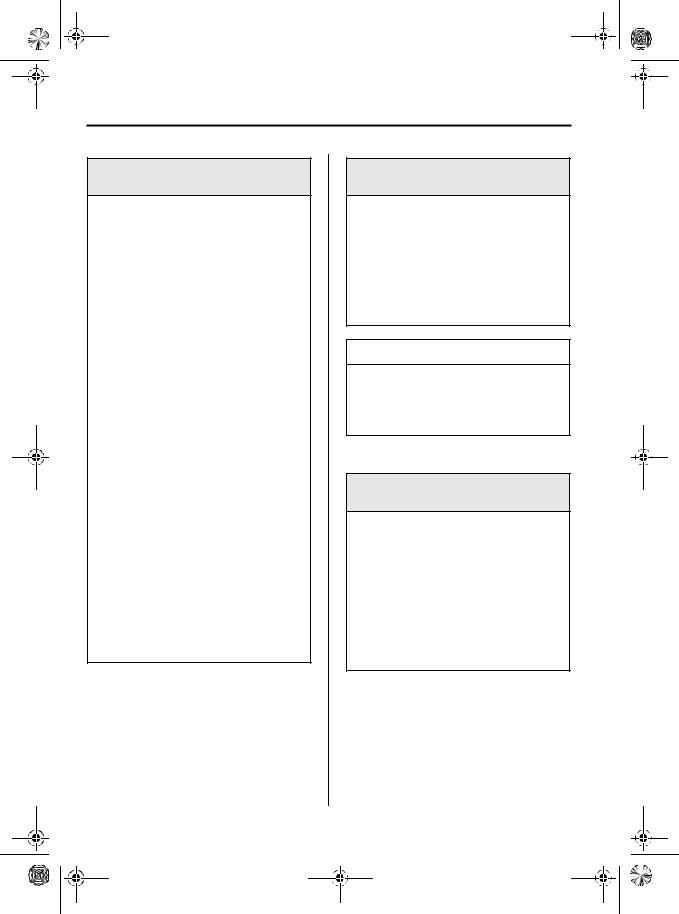
J54L_8R34_EE_02H.BOOK Page 10 Monday, July 15, 2002 9:03 AM
Essential Safety Equipment
Seats
 WARNING
WARNING
Unlocked Seatback:
A seatback plays an important role in your protection in a vehicle. Leaving the seatback unlocked is dangerous as it can allow passengers to be ejected or thrown around and baggage to strike occupants in a sudden stop or collision, resulting in severe injury. After adjusting the seatback at any time, even when there are no other passengers, rock the seatback to make sure it is locked in place.
Passenger on the Folded Seatback: Driving with a passenger on the folded seatback is dangerous. Allowing a child to sit up on the folded seatback while the vehicle is moving is particularly dangerous. In a sudden stop or even a minor collision, a child not in a proper seat or child-restraint system and seat belt could be thrown forward, back or even out of the car resulting in serious injuries or death. The child or other objects in the baggage area could be thrown into other occupants and cause serious injury. Never allow a passenger to sit or stand on the folded seatback while the vehicle is moving.
 WARNING
WARNING
Children and the Folding Rear Seats: Playing with the folding rear seats is dangerous. The folding rear seatbacks cannot be folded down from inside the luggage compartment. Do not give the car keys to children and do not allow them to play in the vehicle.
NOTE
When returning a rear seat to its original position, also replace the seat belt to its normal position. Verify that the seat belt pulls and retracts.
▼Seat Recline
 WARNING
WARNING
Reclining:
Sitting in a reclined position while the vehicle is moving is dangerous because you don’t get the full protection from seat belts. During sudden braking or a collision, you can slide under the lap belt and suffer serious internal injuries. For maximum protection, sit well back and upright.
2-10
Form No. 8R34-EE-02H
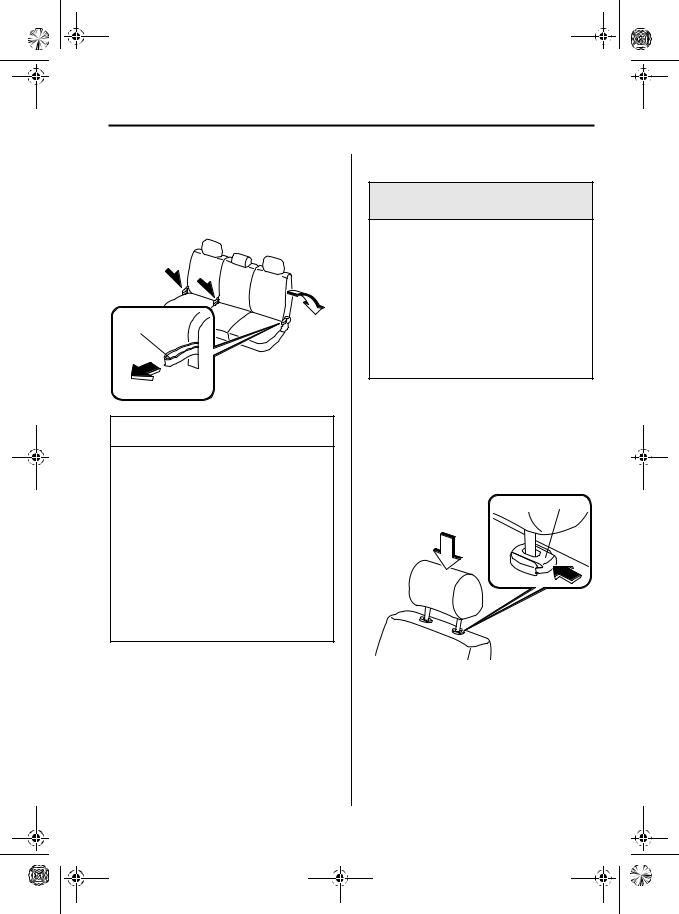
J54L_8R34_EE_02H.BOOK Page 11 Monday, July 15, 2002 9:03 AM
Essential Safety Equipment
Seats
To change the seatback angle, lean forward slightly while pulling the strap. Then lean back to the desired position and release the strap. Make sure the seat is securely latched.
Strap
 CAUTION
CAUTION
•When returning a rear-reclined seatback to its upright position, make sure you support the seatback while operating the strap. If the seatback is not supported, it will flip forward suddenly and could cause injury.
•Reclining the rear seat when the luggage compartment cover is in the first position could damage the seat and cover. Remove the cover or move it to the second position.
▼Head Restraint
 WARNING
WARNING
Head Restraints Adjustment: Driving with the head restraints adjusted too low or removed is dangerous. With no support behind your head, your neck could be seriously injured in a collision. Always drive with the head restraints inserted when seats are being used and make sure they are properly adjusted.
Height adjustment
To raise a head restraint, pull it up to the desired position.
To lower the head restraint, press the stopcatch release, then push the head restraint down.
Stop-catch release
Adjust the head restraint so that the top is parallel with the top of the passenger’s ears, never the passenger’s neck.
2-11
Form No. 8R34-EE-02H

J54L_8R34_EE_02H.BOOK Page 12 Monday, July 15, 2002 9:03 AM
Essential Safety Equipment
Seats
Removal
To remove the head restraint, press the stop-catch release, then pull up on the head restraint.
Stop-catch release
▼Folding the Centre-Rear Seat
 WARNING
WARNING
Using Folded Seatback as a Table While the Vehicle is Moving: Using the folded seatback as a table
while driving is dangerous. During a sudden stop or collision, objects placed on the folded seatback could become projectiles that could hit and injure someone. Never use the folded seat as a table while the vehicle is moving.
The centre-rear seatback can be folded down and used as a table while the vehicle is not moving.
 CAUTION
CAUTION
Don’t sit or lie on the folded seatback. The seat could be damaged.
To fold the centre-rear seatback
1.Unfasten the lap portion of the centrerear seat belt (page 2-46).
2.Secure the centre-rear seat belt in the seat belt retainer (page 2-46).
3.Tuck the rear seat’s seat belt buckle down.
2-12
Form No. 8R34-EE-02H

J54L_8R34_EE_02H.BOOK Page 13 Monday, July 15, 2002 9:03 AM
Essential Safety Equipment
Seats
 CAUTION
CAUTION
Lowering the seatback without tucking the seat belt buckle down could damage the seatback.
4.Pull the strap of the centre-rear seat and lower the seatback forward. Make sure the seatback is locked.
Strap
To return the seatback to the upright position
1.Pull the strap of the centre-rear seat and lift the seatback upright. Attempt to move the seatback forward and backward to make sure it is locked.
2.Fasten the lap portion of the centre-rear seat belt before a passenger sits in the seat (page 2-44).
NOTE
Make sure the centre-rear seat belt is routed between the centre-rear and the left-rear seat.
▼Folding and Stowing Rear Seats
All the rear seats can be flipped and stowed forward to provide more cargo space.
To fold and stow a rear seat
1.Unfasten the lap portion of the centrerear seat belt (page 2-46).
2.Secure the centre-rear seat belt in the seat belt retainer (page 2-46).
3.Remove the head restraint (page 2-11).
4.Tuck the rear seat's seat belt buckles down.
Strap
2-13
Form No. 8R34-EE-02H
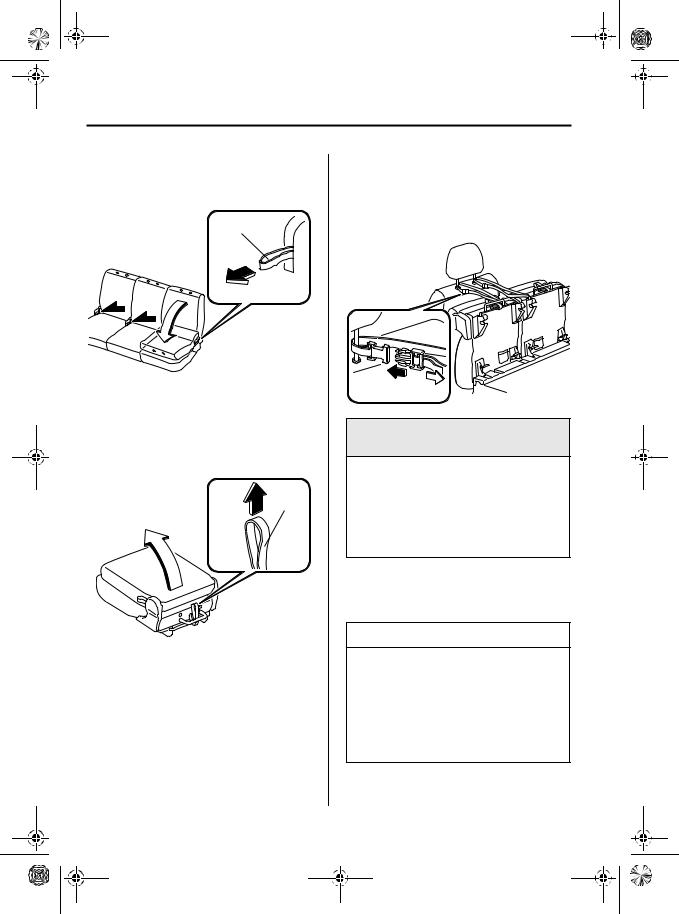
J54L_8R34_EE_02H.BOOK Page 14 Monday, July 15, 2002 9:03 AM
Essential Safety Equipment
Seats
5.Pull the strap and lower the seatback forward. Make sure the seatback is locked.
Strap
6.Work only on one seat at a time to avoid one seat falling while working on another.
7.Pull the strap and raise the entire seat up and forward.
Strap
8.To prevent the rear seats from falling back down, thread the holding strap for each seat around one of the front head restraint uprights and fasten with the buckles.
 WARNING
WARNING
Loose Seat:
A seat not secured with a holding strap is dangerous. The seat could fall down and cause serious injury. Ensure that each stowed seat is secured with a holding strap.
9.Adjust the holding straps to tighten them securely on the head restraint uprights.
NOTE
When stowing the left-rear or centrerear seats, fasten the holding straps on the head-restraint upright of the leftfront seat.
For the right-rear seat, fasten the holding strap on the head restraint upright of the right-front seat.
2-14
Form No. 8R34-EE-02H
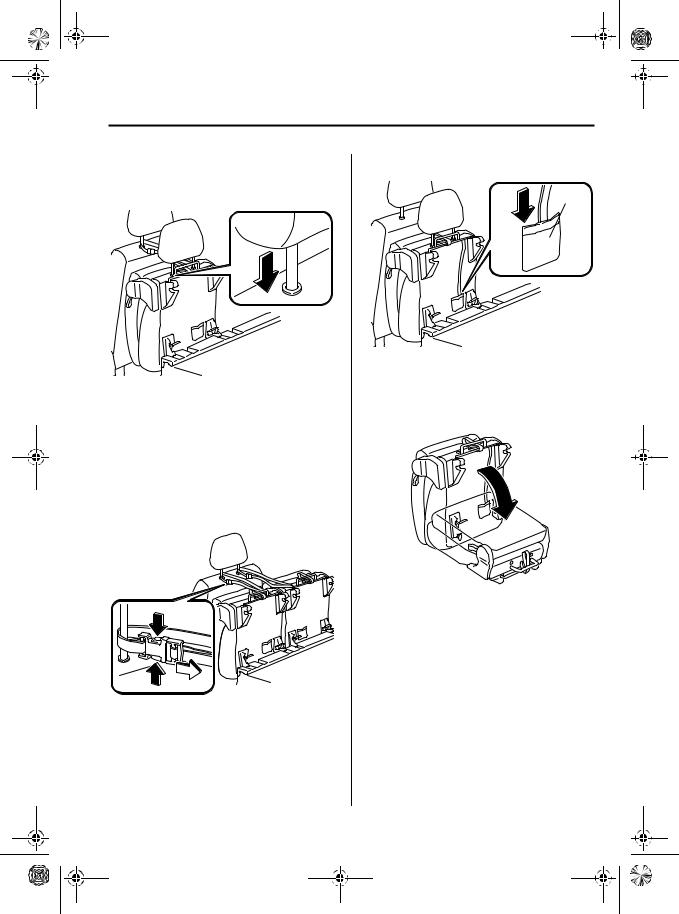
J54L_8R34_EE_02H.BOOK Page 15 Monday, July 15, 2002 9:03 AM
Essential Safety Equipment
Seats
10.Insert the head restraints into the alternate storage holes at the top of the uprighted seat bottom.
To return a rear seat to its original position
1.Remove the head restraint from the back of the uprighted seat bottom.
2.Support the seat while unfastening the holding strap from the head restraint upright so that the seat doesn’t fall down.
3. Tuck the holding strap in the pocket.
4.Carefully lower the seat backward until it locks in place. Attempt to lift the seat up to make sure it is firmly locked down.
2-15
Form No. 8R34-EE-02H
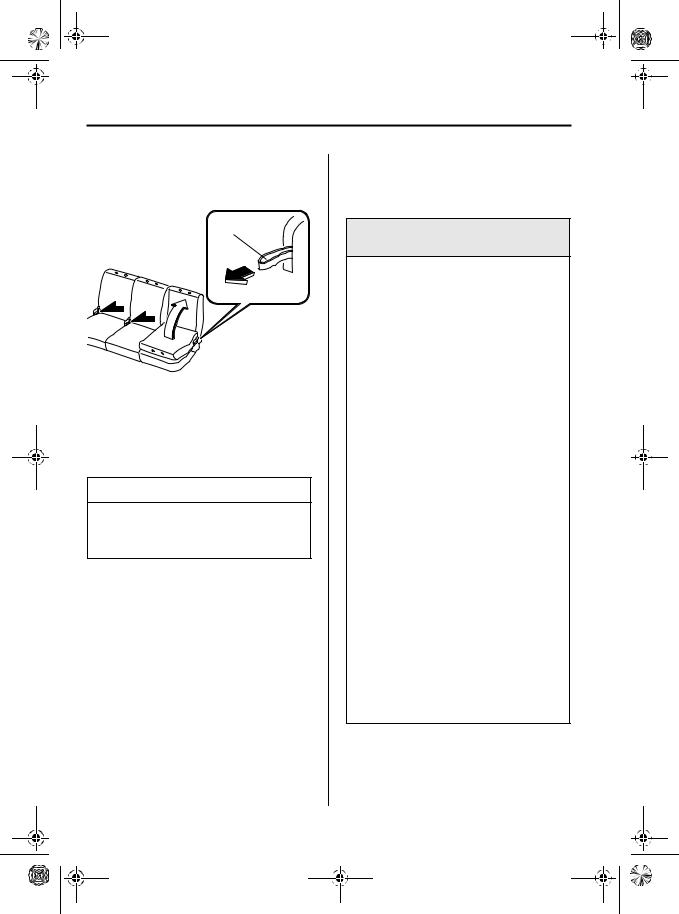
J54L_8R34_EE_02H.BOOK Page 16 Monday, July 15, 2002 9:03 AM
Essential Safety Equipment
Seats
5.Pull the strap and raise the seatback to the upright position. Make sure the seatback is locked.
Strap
6.Reinsert the head restraint to its normal position.
7.Fasten the lap portion of the centre-rear seat belt before a passenger sits in the seat (page 2-44).
NOTE
Make sure the centre-rear seat belt is routed between the centre-rear and left-rear seats.
▼Removal of Rear Seats
All the rear seats can be removed to provide more cargo space.
 WARNING
WARNING
Seat Removal or Installation While Vehicle is Moving or on a Slope: Removing or installing the rear seats while the vehicle is moving or on a slope is dangerous. The seats are heavier than they appear and could suddenly detach causing serious injury. Remove or install the seats with the vehicle parked on a level surface.
Riding on The Floor Space:
Riding on the floor space created by the removal of the rear seats is dangerous. Sudden braking or a collision could cause serious injury. Do not sit or lie in the floor space for the rear seats while the vehicle is moving. Never ride in a vehicle where you can’t sit in the seat and wear the seat belt.
Pinching Fingers or Hands: Placing your hands around the seat anchors when removing or installing
the rear seats is dangerous. You could pinch your hands or fingers between the seat anchor and the seat. Hold the edge of the seat when lowering it into place. Never place your hands between the seat anchor and the seat.
2-16
Form No. 8R34-EE-02H
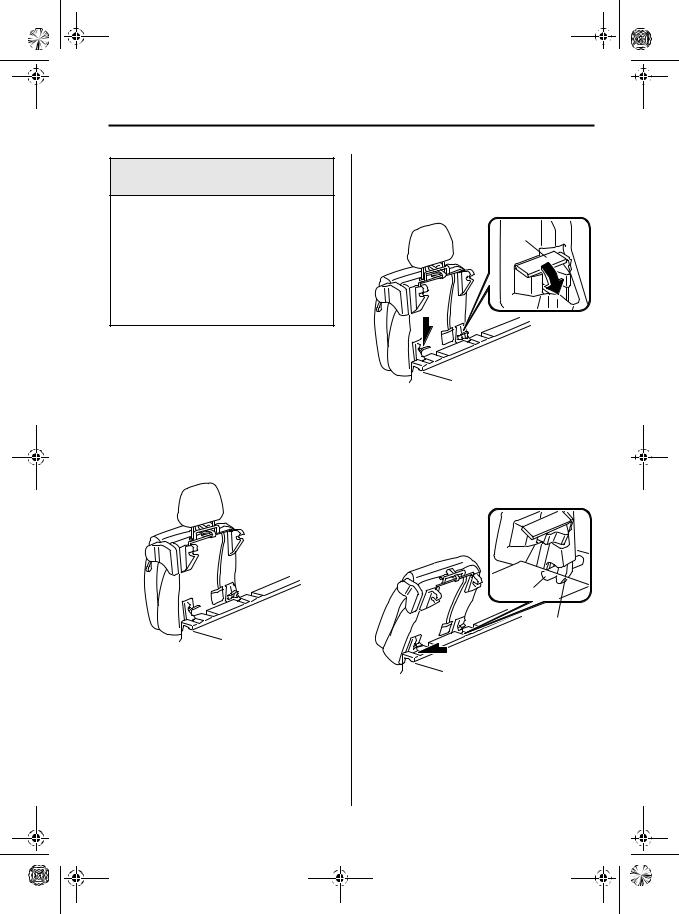
J54L_8R34_EE_02H.BOOK Page 17 Monday, July 15, 2002 9:03 AM
Essential Safety Equipment
Seats
 WARNING
WARNING
Unsecured Seats:
Driving with the seat unsecured is dangerous. The seat may become detached while the vehicle is moving causing serious injury. After installing the seat, attempt to push it forward and backward to make sure it is securely locked.
To remove a rear seat
1.Remove one seat at a time following procedure 1 through 7 of "To fold and stow a rear seat" (page 2-13).
2.While supporting the seat, insert the head restraint into the alternate storage holes at the top of the uprighted seat bottom.
3.Press down each seat lock lever.
4.Remove the seat by tilting it backward to free it from the floor anchors.
Seat lock lever
To install a rear seat
1.If the head restraint is inserted in the seat bottom, pull the head restraint and remove it.
2.Align the seat retaining clamps with the front floor anchors.
Front floor  anchor
anchor
Seat retaining clamp
2-17
Form No. 8R34-EE-02H
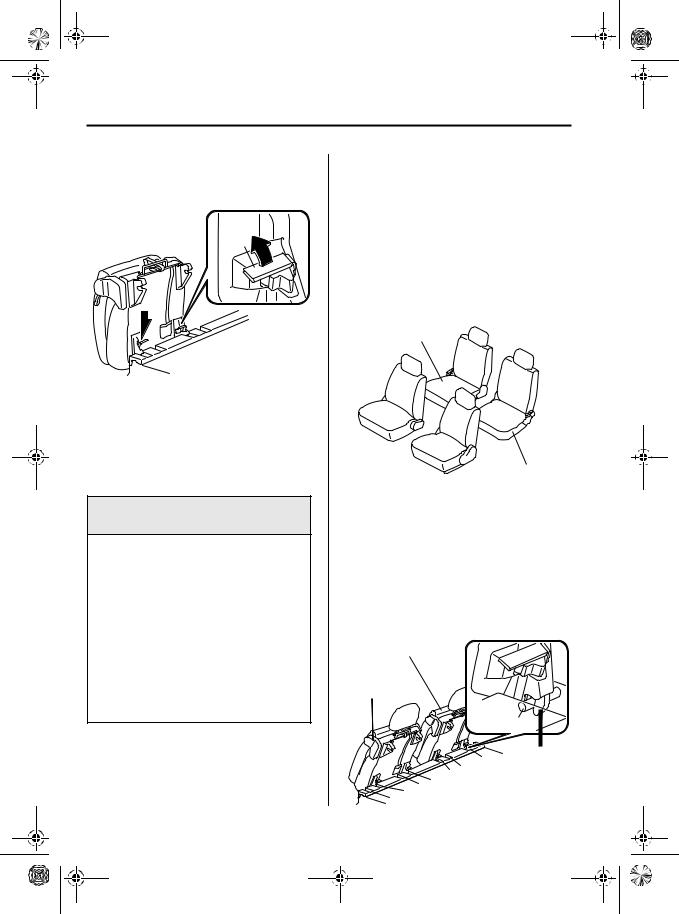
J54L_8R34_EE_02H.BOOK Page 18 Monday, July 15, 2002 9:03 AM
Essential Safety Equipment
Seats
3.Supporting the seat with your hand, raise the seat lock levers on the left and right to lock it in place.
Seat lock lever
4.Return the rear seat to its original position following procedure 4 through 7 of “To return a rear seat to its original position”
▼Four-Passenger Seating Arrangement
 WARNING
WARNING
Rear-Passenger Seating and Seat Belts:
Using the centre-rear seat belt while seated in the left-rear or right-rear seat is dangerous. In a collision or sudden stop, the centre-rear seat belt cannot provide protection for a passenger in the left-rear or rightrear seat. When the centre-rear seat is not in use, stow its seat belt in the retainer and use the appropriate leftrear or right-rear seat belt.
If you plan on carrying only four people and will not need the fifth seat during a trip, your Mazda design allows you to give the rear seat passengers a roomier feeling by taking out the centre-rear seat and moving the remaining two seats inboard for a four passenger vehicle. Make sure the seat belt buckles point inboard for the seats to be properly located.
1. Remove all the rear seats (page 2-16).
Right-rear seat
Left-rear seat
2.Align the seat retaining clamps of the outside seats with the front floor anchors. Align the left-rear seat with the second (2) and fourth (4) positions. Align the right-rear seat with the fifth
(5) and seventh (7) positions.
3.Install the left-rear seat and right-rear seats following procedures 1 through 6 of "To install a rear seat" (page 2-17).
Right-rear seat
Left-rear seat
Front floor |
anchor |
|
(7) |
Seat retaining |
|
(5)(6) |
clamp |
||
|
(1) (2) |
(3) (4) |
|
2-18
Form No. 8R34-EE-02H

J54L_8R34_EE_02H.BOOK Page 19 Monday, July 15, 2002 9:03 AM
Essential Safety Equipment
Seats
Second-Row Seats
(7-Passenger Model)
 WARNING
WARNING
Stacking Cargo:
Stacking luggage or other cargo higher than the seatback is dangerous. During a sudden stop or collision, objects can become projectiles that could hit and injure passengers. Don't stack things higher than the seatback.
Securing Seats:
Adjustable seats and seatbacks that are not securely latched are dangerous. In a sudden stop or collision, the seat or seatback could move, causing injury. Make sure the adjustable components of the seat are locked in place by attempting to slide the seat forward and backward and rocking the seatback.
Seat Adjustment:
Adjusting the seat while the vehicle is moving is dangerous. Sudden braking or a collision could cause serious injury. Adjust the seat only when the vehicle is stopped.
 WARNING
WARNING
Unlocked Seatback:
A seatback plays an important role in your protection in a vehicle. Leaving the seatback unlocked is dangerous as it can allow passengers to be ejected or thrown around and baggage to strike occupants in a sudden stop or collision, resulting in severe injury. After adjusting the seatback at any time, even when there are no other passengers, rock the seatback to make sure it is locked in place.
Passenger on the Folded Seatback: Driving with a passenger on the folded seatback is dangerous. Allowing a child to sit up on the folded seatback while the vehicle is moving is particularly dangerous. During sudden braking or even a minor collision, a child not in a proper seat or child-restraint system and seat belt could be thrown forward, back or even out of the car resulting in serious injuries or death. The child or other objects in the baggage area could be thrown into other occupants and cause serious injury. Never allow a passenger to sit or stand on the folded seatback while the vehicle is moving.
NOTE
When returning a second-row seat to its original position, also replace the seat belt to its normal position. Verify that the seat belt pulls and retracts.
2-19
Form No. 8R34-EE-02H

J54L_8R34_EE_02H.BOOK Page 20 Monday, July 15, 2002 9:03 AM
Essential Safety Equipment
Seats
▼Seat Slide
To move the seat forward or backward, raise the bar and slide the seat to the desired position.
Bar
Make sure the bar returns to its original position and the seat is locked in place by attempting to push it forward and backward.
 CAUTION
CAUTION
Be careful when moving the secondrow seat while a passenger is seated on the third-row seat. The passenger’s legs could be pinched or otherwise injured.
To slide the seat further back, raise the bar and slide the knob to the right at the same time. Slide the seat all the way back, then release the bar and the knob.
▼Seat Recline
 WARNING
WARNING
Reclining:
Sitting in a reclined position while the vehicle is moving is dangerous because you don’t get the full protection from seat belts. During sudden braking or a collision, you can slide under the lap belt and suffer serious internal injuries. For maximum protection, sit well back and upright.
Reclining the Second-Row Seatback: Reclining the second-row seatback when the third-row seat is occupied is dangerous. The second-row seatback may hit and injure the occupants in the third-row seat. Don’t recline the second-row seatback when the thirdrow seat is occupied.
To change the seatback angle, lean forward slightly while pulling the strap. Then lean back to the desired position and release the strap.
Knob
Strap
2-20
Form No. 8R34-EE-02H

J54L_8R34_EE_02H.BOOK Page 21 Monday, July 15, 2002 9:03 AM
Essential Safety Equipment
Seats
Make sure the strap returns to its original position and the seatback is locked in place by attempting to push it forward and backward.
 CAUTION
CAUTION
When returning a rear-reclined seatback to its upright position, make sure you support the seatback while operating the seatback strap. If the seatback is not supported, it will flip forward suddenly and could cause injury.
▼Head Restraint
 WARNING
WARNING
Head Restraints Adjustment: Driving with the head restraints adjusted too low or removed is dangerous. With no support behind your head, your neck could be seriously injured in a collision. Always drive with the head restraints inserted when seats are being used and make sure they are properly adjusted.
Height adjustment
To raise a head restraint, pull it up to the desired position.
To lower the head restraint, press the stopcatch release, then push the head restraint down.
Stop-catch release
Adjust the head restraint so that the top is parallel with the top of the passenger’s ears, never the passenger’s neck.
Removal
To remove the head restraint, press the stop-catch release, then pull up on the head restraint.
Stop-catch release
2-21
Form No. 8R34-EE-02H

J54L_8R34_EE_02H.BOOK Page 22 Monday, July 15, 2002 9:03 AM
Essential Safety Equipment
Seats
▼Removing Shoulder Restraint
To fold the second-row seat and the front seats flat, remove the shoulder restraints.
▼Third-row Seat Access
To reach the third-row seat, pull the strap on the second-row seat, fold the seatback forward and slide the seat forward.
Strap
The third-row passengers have a similar strap on the back side of the second-row seat. Pull the strap to fold the seatback of the second-row seat forward and slide the seat forward.
To return the second-row seat to its original position, slide the seat to the desired position and raise the seatback upright.
Strap
▼Folding the Second-Row Seat
 WARNING
WARNING
Using Folded Seatback as a Table While the Vehicle is Moving: Using the folded seatback as a table
while driving is dangerous. During a sudden stop or collision, objects placed on the folded seatback could become projectiles that could hit and injure someone. Never use the folded seat as a table while the vehicle is moving.
The second-row seatback can be folded down and used as a table when the vehicle is not in motion.
Long objects can be also placed inside when the front passenger seat is folded down as well. Make sure objects are secured.
2-22
Form No. 8R34-EE-02H
